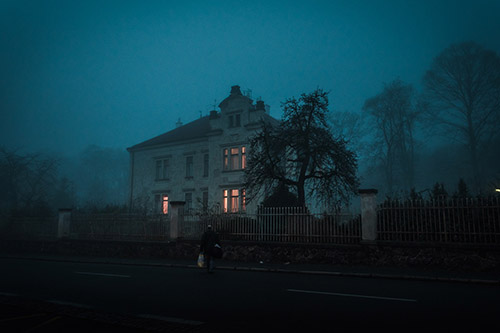Writing horror is one of the most cathartic things you can attempt. As a Gothic horror writer myself, I’m naturally biased in advising people to have a go! (And I have a class to help you write your own haunted house story if you’re interested)
But we don’t always necessarily think of world-building when it comes to horror. That in itself is a glaring omission! So Jamie Ryder from the Tales of the Frontier series is here to walk you through how and why world-building is so useful to horror!
Stephen King. H.P Lovecraft. Edgar Allan Poe. Dean Koontz. These heavyweights of horror all have their own unique writing styles, life experiences and fears that are brought to life on the page. They all have in common their ability to craft vivid worlds that terrify and reflect real-life issues, which make readers feel like they’re inhabiting a tangible space.
Geeking out about the mechanics and psychology of horror world-building is fun for me. These authors have all inspired my writing journey and the development of Tales Of The Frontier (TOTF), a western horror universe filled with magic, monsters and mayhem.
Whether you’re working on your own original horror world or have had something established for years, I think it’s worth hearing the perspectives of different writers to see how they’ve gone about building a world from scratch.
In this article, I’m discussing the lessons I’ve learned about world-building that work for any fantastical genre. This isn’t a how-to guide, a piece about writing success or an advice column. Just a set of subjective observations that you’re free to take on board. Or not.
Create a gateway faction
My favourite fantasy epics and horror series are the kinds that have a relatable group of people who offer a gateway to a world that’s not grounded in reality. An example that comes to mind is The Greatcoats from Sebastien de Castell’s Greatcoat series.
They are a group of magistrates who want to fulfil their king’s dream of bringing justice to the land of Tristia. Of course, it’s never that simple and each Greatcoat comes with their own baggage and subjective experience of what they feel about their home and whether it’s worth saving at all.
Through this gateway faction, de Castell pushes the reader into his fantasy world and we get to feel the politics, religious beliefs and laws that govern the land.
For Tales Of The Frontier, I created a group of monster hunters called Questers. They defend the innocent against creatures of the dark and seem like the ‘good guys’ on the surface. But each Quester is their own person and has their own way of doing things that’s questionable at best, psychotic at worst.
Make a comparison to well-known titles
When creating your horror world, a useful exercise is to compare it to other series. There are a couple of benefits to doing this.
First, you can clarify what makes your world unique and avoid plagiarising or cliches.
Second, you can create a killer elevator pitch when describing your work to publishers, agents, friends, family, that randomer in the pub, their dog and anyone else you think will listen.
For TOTF, I describe it as Red Dead Redemption meets The Witcher because of the monsters/magic theme and western setting.

Build in public
If you’re looking for fast feedback for your horror world, there’s nothing like creating it publicly. The advantages to this include pushing you to write more, bringing readers along and experimenting with what works and what doesn’t.
The first step to building in public is to find an online platform you feel comfortable with. My recommendation is Substack for a few reasons [Icy – I don’t recommend Substack for various reasons and so, therefore, don’t use it. I use ConvertKit for contacting readers]. The interface is easy to understand and can be used as a newsletter and website for producing regular content. There are video and audio features to branch out within your storytelling and you can tap into the community to recommend other Substacks and grow your following organically.
Another way to build in public is through serialised storytelling. Once you’ve found your platform, start publishing flash fiction, short stories and novel chapters to get readers excited and keep them coming back for more.
Create ongoing segments for your characters
Looking to go deeper with the motivations behind your protagonist? Need to figure out a way of hooking your audience without writing another story? Think about creating ongoing segments for your characters that extend the world and provide more backstory about them.
What do I mean by this? Something I love doing with TOTF is creating different drinking cultures i.e. in one region, people like drinking and producing whisky, whereas in another part of the world, rum is the king of spirits.
Knowing that one of my protagonists, the infamous witch hunter Clay McNab is a whisky man, I’ve written about some of the whiskies he’d enjoy drinking in the ‘real’ world as a way to provide some more depth into his personality. (I plan to do more articles about the drinking habits of different Frontier characters and it’s a fun way to provide a steady stream of content).

Use exposition to your advantage
Remember the classic writing rule of show don’t tell? Well, it’s a rule you can break to provide further intrigue about your world and help you develop new ideas.
What this looks like in action for me is producing articles about the religion, politics and landscape of The Frontier as an extra resource for readers to look at if they’re interested. But when it comes to writing TOTF fiction, it’s back to showing rather than telling.
Here are some expositional ideas that you could use:
- Write about the architecture or regions of your world and explain the flora and fauna
- Create a video series about the religious system and what each god represents
- Create a specific ‘tour guide’ narrator that guides readers through your world and what to expect
Happy horror world-building!
Bio: Jamie Ryder is a horror and fantasy author living in Manchester. He’s the creator of Tales Of The Frontier, a horror western world that you can check out through his free newsletter. He published his first short story collection Transmutations in 2022.
Keen to improve your writing?
Grab your list of my top 5 blogs, books, and podcasts for fiction writers below!







Have your say!